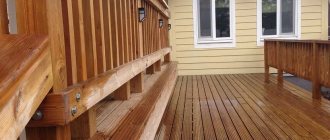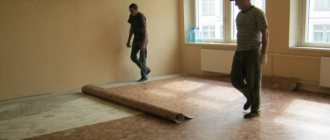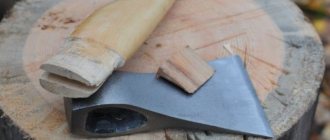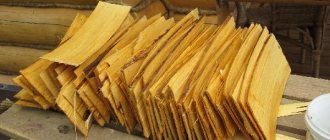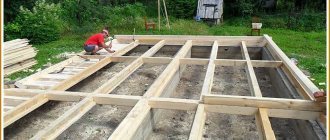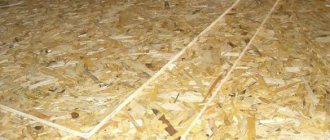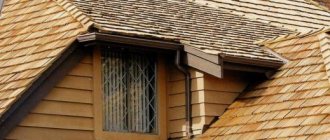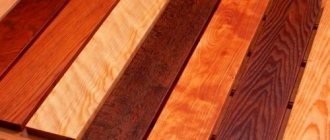One of the main criteria for a comfortable life in a home is the optimal temperature level, as well as a suitable humidity level. Properly installed layers of heat, moisture and vapor insulation will help ensure good performance. Moreover, correctly laid layers not only improve the microclimate in the house, but also protect the floors from the effects of various factors, including humidity. How to properly install a vapor barrier on the floor?
Floor vapor barrier
Hydro-vapor barrier film
How to properly install a vapor barrier on the floor
Diffusion membranes
The most expensive material used for durable and high-quality vapor barrier is diffusion membranes. People called them “breathing”.
In such membranes, regulation of the moisture level is achieved by allowing air to pass through on one or both sides, so the membranes come in single-sided and double-sided varieties.
When laying a one-sided membrane, it is important not to confuse the side that is applied to the insulation. This aspect is not taken into account if a double-sided membrane is used
In terms of its microstructure, the membrane is a non-woven material made from artificial fibers that provides a significant coefficient of vapor permeability. The membrane is classified by the number of layers - there are one, two or three layers. In addition, there may be an additional anti-condensation layer, which is responsible for the accumulation of moisture and its further evaporation.
Among the breathable membranes, the most popular and versatile are multilayer smart membranes that allow you to regulate vapor exchange, taking into account the level of humidity and room temperature. Such membranes simultaneously have the qualities of waterproofing, vapor barrier and thermal insulation.
In addition, when using breathable diffusion membranes, there is no need to create a gap between the membrane and the insulation, which saves space and greatly simplifies installation work.
But the material also has a drawback - its high price. However, the simplicity of installation work, durability and reliability of the vapor barrier make it possible to recoup its cost. The use of diffusion membranes provides durable and reliable protection of the floor from moisture, increasing the performance of the structure.
How to check if the vapor barrier is working
There is a very simple way to check the effectiveness of a vapor barrier. You need a small piece of material and two glasses of the same diameter. Pour boiling water into one glass, cover it with a piece of the material being tested, and place the second glass upside down on top. If the material works as it should, the second glass remains dry.
If drops form on the walls, “fog” appears, the material conducts steam. Perhaps you have a vapor barrier with one-way conductivity, then you need to turn it over and repeat the tests. The situation has not changed? This is a vapor-permeable material with two-way vapor conductivity.
Vapor barrier for floors in a wooden house
In a wooden house, the ground floor floors are prepared on the ground. The design of the floor is very simple and is a multi-layer cake of the following type: “dirty” floor, wood blocks, hydro-, steam- and thermal insulation, finished floor and floor covering. The floor structure itself is placed on supporting brick pillars or concrete. Between the wooden floor and the ground there is an underground space that has its own ventilation.
It is recommended to create a vapor barrier for a wooden floor during the construction stage of a house. Of course, sometimes it is necessary to do a comprehensive repair of an already finished one, but in any case, the creation of a vapor barrier begins with the preparatory stage.
Preparation work
If, for example, a house is being built from scratch, then there are fewer worries. The very first thing is that all floorboards are made of wood.
should be treated with a special composition against rotting, fungi and insect pests. This is especially true for the cross beams and base floor, since they are closest to the ground. Secondly, you should replace the wood blocks and refine the “dirty” floor, on which the steam and thermal insulation will lie.
In case of major repairs or development of a vapor barrier for an already finished wooden floor
you need to do the following. The very first thing is to remove the old floor covering and finished floor, remove the thermal insulation and what previously could have been a vapor barrier. Second, check the condition of the base floor and cross beams for rotten or sagging boards. If such are found, then it will be necessary to completely or partially replace them and treat the wood blocks and the “dirty” floor with protective agents. Only after they have been repaired and put in place, we begin laying the vapor barrier.
Laying vapor barrier on the floor
All work on laying vapor barriers is a primitive set of sequential actions; they do not require any special skills or knowledge. For vapor barrier of wooden floors, film materials are usually used, one of the light representatives of which is vapor barrier
Izospan B floors and Izospan membrane fabric.
We lay the Izospan vapor barrier on the “dirty” floor, gluing the joints with specialized tape
We lay the Izospan vapor barrier on the supporting frame of the base floor, making sure that the sheets overlap one on one, and the overlap width is 15 - 20 cm. To fasten the Izospan vapor barrier, you can use zinc nails or a specialized construction stapler, but many manufacturers of “breathing” vapor barriers films and films, it is recommended to use specialized adhesive tape. Therefore, when purchasing a vapor barrier, you need to clarify the method of its fastening. A positive quality of the tape is the ability to create a solid coating without cracks or joints. To do this, we simply glue the overlapping areas.
Important! When laying the vapor barrier, make sure that it is laid with the required side facing the thermal insulation. Otherwise, moisture will accumulate and spoil the heat insulator.
We lay the Izospan vapor barrier on top of the heat insulator, seal all the cracks and joints with tape
We lay a thermal insulation layer on top of the vapor barrier. This can be mineral wool, polystyrene foam or any other material for thermal insulation. The main thing is that it fits tightly to the cross beams, and there are no gaps or cracks between them. We again lay a vapor barrier layer on top of the heat insulator, making sure that the sheets overlap. After this, we glue the joints and begin installing the finished floor and floor covering.
Wood flooring is very demanding to work with and puts forward strict requirements for its own protection from the negative effects of a variety of factors. First of all, this concerns the level of moisture, since wood is very sensitive to it. However, thanks to today's technologies and people's desire to create reliable and durable structures, hydro- and vapor barrier materials have emerged. They are easy to install and perfectly protect wood from damage, and their scope of use also extends to roofs and walls of wooden houses.
In the case of using foil vapor barrier, first of all, keep in mind the fundamental point: it should be laid with the metallized side up, so that heat is repelled into the room, and also lay it end-to-end, gluing it with aluminum-based tape.
How to lay a vapor barrier
The vapor barrier must be installed in compliance with the technology, although in general this process is quite simple and understandable to everyone.
Step 1. Windproof material is spread over the subfloor.
Laying windproof material
Step 2. The film is laid so that its edges overlap the wooden logs.
The film is attached to the logs
Step 3. The material is fixed using a construction stapler along the joists.
A stapler is used for fixation
Step 4. After this, insulation boards are laid on the laid material. They must cover all the space between the joists.
Laying insulation
Step 5. Adhesive tape is glued along the perimeter of the wall in its lower part before installing the vapor barrier layer.
Adhesive tape is applied around the perimeter
Step 6. A vapor barrier layer is laid. Pieces of the required size are laid across the joists with a slight overlap on the walls. The film is laid so that it sags a little in the middle.
Laying vapor barrier
Step 7. The film is fixed using a construction stapler on the joists.
Fastening vapor barrier material with a stapler
Step 8. The edge of the vapor barrier film, placed on the wall, is glued to it using the adhesive tape installed earlier.
Vapor barrier film placed on the wall is glued to adhesive tape
Step 9. The junction of the next layer of film is sealed using adhesive tape, which is glued along the edge of the previously laid layer.
The joints between the film pieces are sealed with adhesive tape.
Step 10. A new piece of material is laid so that there is an overlap at the location of the adhesive tape. The rest of it is again fixed to the joists using a construction stapler.
The second piece of vapor barrier film is laid
Step 11. The floor is being installed.
Floor installation
Prices for liquid rubber for waterproofing
liquid rubber for waterproofing
Video - Installing vapor barrier
Do-it-yourself installation of floor vapor barrier in a wooden house
Most often, floors in a wooden house on the ground floor are made directly on the ground. Often a very primitive design is used, when a subfloor, joists are laid, then vapor barrier, thermal insulation, waterproofing, then the finished floor and only then the floor covering. This entire structure rests on support pillars made of brick, concrete or stone.
The underground, which is also the space between the wooden floor and the ground, is equipped with its own ventilation. Typically, vapor barrier of the floor is done during the construction stage. If the house is already in use and a major renovation is required with the obligatory reconstruction of the vapor barrier, then the installation begins with preparation.
Vapor barrier layout diagram
Vapor barrier layout diagram
The main function of the vapor barrier film is to protect the wooden floor of the log house and insulation from the penetration of steam and condensation. In this regard, the vapor barrier must be located between the insulation layer and the finished floor.
As a rule, two layers of vapor barrier are laid, the second layer is placed between the heat insulator and the subfloor. The bottom layer prevents moisture from the soil from penetrating into the structure. Often, instead of a second layer of vapor barrier, a waterproofing film is laid.
A lower vapor barrier must be done when the subfloor is located in close proximity to the ground or is located above a damp basement.
Choosing a vapor barrier
In the process of arranging floors and other enclosing structures of a wooden house, it is necessary to select and buy one or another type of vapor barrier film. Considering the variety of types and offers on the market, a logical question arises: “which vapor barrier is better?” The answer to this cannot be unambiguous, since the correct choice is made only based on compliance with the following requirements:
- Firstly, the technical characteristics of the vapor barrier itself.
- Secondly, the operational characteristics of the room or fence where the vapor barrier will be installed, and their compliance with the previous paragraph.
- Thirdly, the cost of the film itself.
- Fourthly, the volume and price of installation work (it was previously mentioned that polyethylene/propylene films, according to the manual, require a ventilation gap, which complicates the installation of a wooden floor).
Practical installation recommendations
It is better to lay the floor on transverse beams - logs. In this case, the ceiling itself will have a spherical structure - a kind of motley “Napoleon pie”. The layer diagram looks like this:
1. Logs and cranial bars. The former are used as support and fastening beams for the main covering, as well as providing the required rigidity. The second is laid on both sides of each joist to ensure clearance of the subfloor boards or slabs from the ground/foundation.
2. Primary floor layer. Placed on the previously mentioned bars. It can be organized from boards or slabs (for example, OSB).
3. Waterproofing. The first barrier layer that prevents water from penetrating into the “pie” from below. The individual elements of the roll are laid with an overlap (150–200 mm), and the connection is made using double-sided tape.
4. Insulation. The most commonly used materials are mineral wool, fiberglass or polystyrene foam of the required thickness. Individual sheets are placed in such a way that there is no gap left between them and the joists.
5. Vapor barrier. The installation principle is the same as in the case of a hydraulic barrier.
6. Counter rails. Longitudinal wooden blocks 10–20 mm high, which provide a guaranteed ventilation gap. If a diffuse membrane film is used as the latter, then they do not need to be installed.
7. Wooden floor. This stage can be final or intermediate, if, for example, laying laminate flooring is planned.
Prices
The price of vapor barrier on the Russian market depends on its type, characteristics and regional features/rates:
| Manufacturer/region | Brand | Barrier type | Price, rubles |
| AMK-GROUP, Novosibirsk | TYVEK AIRGUARD REFLECTIVE | Membrane | 11 860 |
| ISOFLEX SOUTH, Sochi | NANOIZOL V | 1 000 | |
| KREPEZhCITY, Kazan | ONDUTIS R TERMO 25 | Reflective | 600 |
| LTK, St. Petersburg | MEGAIZOL V | Laminated polypropylene | 770 |
| GRATA, Kazan | ISOVEK AT 70 | 720 | |
| MTK, Novosibirsk | ROKWOOL | 920 | |
| RSL-INVEST, Novosibirsk | ISOSPAN V | Rough polypropylene | 1 000 |
Materials and tools for work
In addition to the vapor barrier film, the following materials will be needed to install a vapor barrier:
- double-sided adhesive tape for fixing the film;
- insulation, usually mineral wool is used for wooden floors;
- wooden slats for mounting the counter-lattice on top of the film;
- self-tapping screws for fastening the slats.
To perform the work you will also need tools:
- screwdriver for flooring and installation of sheathing;
- construction stapler for securing film.
Types of vapor barrier materials
In construction, various materials are used for waterproofing and vapor barrier:
- polyethylene and polypropylene film;
- breathable (diffuse) membranes;
- bitumen mastics;
- liquid rubber.
The last two types are suitable for concrete surfaces and are not used on wooden structures. Each of the listed types of waterproofing and vapor barrier has its own characteristics.
The most common and budget option for vapor barrier is polyethylene sheet. It comes in different thicknesses. Consists of 1-2 layers.
Manufacturers produce perforated and non-perforated polyethylene film. The first is used for waterproofing. It contains micro-holes with a higher degree of vapor permeability (Sd=1...2 m). In non-perforated products this indicator is lower (Sd=40...80 m). Because of this, it is used as a vapor barrier.
Modern development of polyethylene films for hydro- and vapor barriers - products with reflective aluminum coating. The vapor barrier ability of this type is higher than traditional samples. It is used to protect plank floors in rooms with elevated air temperatures and humidity exceeding optimal parameters: in kitchens. In bathrooms, saunas, baths.
The main disadvantage of polyethylene sheets is low strength. Any impact will cause them to break.
They are mounted with extreme caution, trying to avoid sharp corners and strong tensions. They have a short shelf life
A more durable and wear-resistant artificial material is propylene. It is similar to the previous option, but surpasses it in quality and performance characteristics when used as a hydro- and vapor barrier product for a wooden floor.
Polypropylene reinforced fabrics, in addition to the main synthetic layer, have a viscose-cellulose insert. It is she who absorbs a large amount of liquid and holds it to prevent the formation of drops. When the air temperature rises, the humidity level drops, and this layer dries out. To make the process happen faster, an effective ventilation system is created.
The main advantage of polypropylene products is a high degree of resistance to any weather conditions. They are strong and durable, affordable and quite easy to install. When using polypropylene sheets for hydro- and vapor barrier, the anti-condensation layer is turned towards the rough flooring boards. A ventilation gap is created between the insulation mats and the film.
The most expensive material for hydro-vapor barrier is breathable (diffuse) membranes. These are high-quality modern products with a high coefficient of vapor permeability. They have a special microstructure. The basis of this material is a non-woven fabric woven from synthetic fibers.
Breathable membranes come in 1-2-3 layers. They contain a special anti-condensation layer in which moisture accumulates and then evaporates. Multilayer products include smart membranes. They combine the properties of hydro-, heat- and vapor barrier, and have the ability to independently regulate steam exchange depending on the level of humidity and temperature.
A serious advantage of breathable membranes is the possibility of using them without a ventilation device. This property allows you to save space on the floor by making the ceiling higher. When using these products, there is no need to install additional insulation.
Diffuse membranes are a durable, wear-resistant material that reliably protects boards from moisture. It is expensive, but has a long shelf life and is easier to install.
To choose the right material for vapor barrier of a wooden floor, you should correlate the structural features, the design of the rough and final coating, and financial capabilities.
Vapor insulation materials
At the moment, the industry presents a fairly large range of materials for vapor insulation. Almost all of them are artificial polymers, since fibers of natural origin are characterized by excellent water absorption and transmission in two directions.
An important criterion for the quality of such products is the impossibility of steam passage. This is defined as the amount of water in grams that can pass through a square meter in a day: grams per square meter. Good permeability should not exceed 15-20 grams per square meter.
You can create a vapor barrier using various materials
If you look at the pros and cons of materials, then you need to analyze the material from the angle of the following qualities:
- service time;
- mechanical strength;
- the ability to pass air and at the same time hold water.
When choosing a material, you need to take into account strength, ability to pass air and retain water
Most of these materials are characterized by an insufficiently high ability to provide access to air, as a result of which a greenhouse effect occurs in housing. People should systematically ventilate the house, even if the winter weather outside is cold.
Let's consider a comparative table of materials, which describes the advantages and disadvantages, as well as the degree of budget.
| Material | Characteristic |
Polyethylene film reinforced with fiberglass mesh | The cheapest option that provides heat insulation. You can buy it in rolls. It has very low strength and a short service life. Therefore, it is better to take a model reinforced with fiberglass mesh. This allows you to strengthen the material, as a result of which it “lives” longer. This film protects well from steam, but it does not allow air to pass in either direction. Therefore, condensation may accumulate on the material; water from the natural drying of the wood remains. The effect of this isolation is doubtful. |
Polyethylene film with a layer of lamination and metal foil | This material costs a little more. As for insulation from steam, the performance is similar to the first material, however, the metal surface allows you to accumulate heat, drying the condensate. |
Foam backing with foil surface | This material is completely moisture- and vapor-proof. It differs from the others in that it insulates heat. The metal side of the film is placed towards the home, allowing it to effectively reflect heat. Based on the thickness, the thermal insulation properties of the material are considered. |
Diffuse membrane | A quality option. The idea is that the membrane allows steam to pass in one direction. In other words, moisture will come out of the floor, but new moisture will not appear. The price of the material is rather high, and it is also not always suitable for vapor insulation of walls on the street side. |
Izospan | Another membrane material. In addition to flooring, it is used to insulate walls from the outside, as well as for roofs and ceilings of buildings. This is a one-way material that does not allow steam to pass in the opposite direction at all. There are several varieties - we will talk about them a little later. The film is of high quality and can withstand gusts of wind without any problems. Installs very easily. The best option in our case. |
If you puncture small holes in polyethylene or propylene film, you will not get enough air. The floor must receive air directly from the entire surface. In addition, warm air will enter such holes along with the water that has evaporated there. Therefore, this material makes no sense.
Wooden floor and liquid rubber
Types of membranes for vapor insulation
If we look from the point of view of consumer properties, it is advisable to divide the materials for the insulation we are considering into membranes and others. The reason is that the membrane is a new generation material, it is not similar to the usual polymers of artificial origin.
Main advantages:
- they allow water to pass through in volumes of no more than 10 grams per square meter per day, so they are very often used in rooms with high humidity (for example, a bathhouse);
- since the structure of the material is porous, it perfectly holds condensation, preventing it from getting into the insulation material;
Vapor barrier membranes can be used when arranging a bathhouse
- the material copes with temperature changes from minus 40 to plus 80;
- since the structure is reinforced, the fibers can cope with work without wearing out for ten years or more;
- the porous structure provides excellent gas exchange between the home and the environment;
- Some of the membranes are reinforced with foil, which reflects heat coming from the room, so they help the insulation material maintain the internal temperature of the house in winter.
Based on their functions, membranes can be divided into:
- anti-condensation – preventing water from penetrating;
- foil - in addition to insulating steam, they leave heat.
Membranes can be anti-condensation or foil
If you look at market prices, the cost of membranes is quite high compared to other materials. Let's look at the price tag for a 75 square meter roll.
| Brand | Cost in rubles |
| "Tyvek Soft" | 5200 |
| "Delta Vent N" | 8900 |
| "Delta Maxx" | 12100 |
| "EUROTOP T150" | 8000 |
The cost of membrane vapor barrier is quite high, but its properties justify the price
To a large extent, the production of membrane material is carried out in Germany. The high cost will pay off if the owner plans to thoroughly decorate his house. If you do the math, constantly replacing the insulating material and laying out a new vapor insulator will cost more than choosing high-quality materials.
Main types of vapor barriers
A wooden house involves several areas where it would be good to install a vapor barrier. In addition to the floor covering under consideration, an additional barrier often has to be installed in basements, attics, and also in the presence of uninsulated ventilation and furnace ducts. Therefore, it is necessary to know what kind of vapor barrier there is and its applicability in each specific case. They can be divided into three main groups:
1. Painting room. It is a liquid or plastic mixture (bitumen, tar), which is applied to uninsulated metal surfaces (roofing, chimneys). The barrier prevents the formation of condensation, which causes the development of corrosion areas.
2. Film. Thin roll insulation made of dense or membrane materials (polyethylene, polypropylene). Most often used in private housing construction to create a vapor barrier for a wooden floor.
3. Antioxidant film. Used as a safety net, especially at ventilation outlets and chimneys on the roof.
Considering that the topic of the article is the vapor barrier of a wooden floor, we should dwell in detail on the second group. In practice, three main types of films are used:
1. Polyethylene. The most accessible and familiar type, successfully used in the construction of not only floors, but also greenhouses. Depending on the surface texture, these films can be smooth, perforated or aluminized. As a material, polyethylene has low strength, so you need to work with it carefully. As for the barrier properties directly, the best level of vapor barrier is provided by a laminated film - its permeability indicator is at the level of 200 m, whereas for a regular smooth film it is good if it reaches 60 m. It should also be noted that a two-layer barrier additionally retains heat inside the room.
2. Polypropylene. More durable material. The level of vapor permeability reaches 100 m. It is often also two-layer, one side of which is smooth, and the other is woven - a combination of viscose-cellulose fibers - or fleecy. This solution allows you to better retain moisture and evaporate it faster. A striking example is the film Izospan B and Rockwool.
3. Membrane. This is a modern type of vapor barrier, the cost of which, naturally, is higher than its analogues. Multilayer material regulates moisture concentration well, as a result of which there is no need for ventilation gaps during installation.
Installation of floor heating systems
The design of underfloor heating involves the installation of heating mats or infrared roll-out floor heating systems under:
- finishing coating laid using a floating method (parquet boards, laminate);
- floor tiles or porcelain stoneware laid in wet areas.
Laying tiles on an infrared floor heating system
Manufacturers recommend installing a heat-steam-hydrobarrier with the reflective side facing the heating element. However, here you can successfully use ordinary foil-coated isolon or EPS, the cost of which is 2-5 times less than its membrane competitor.
The final scheme of work is as follows:
- Rough base
- Reflective vapor-waterproofing;
- Floor heating system, taking into account the characteristics of the type used (for example, infrared mats cannot be installed under heavy furniture);
- Finish floor covering
Installation of hydro-vapor barrier for floors in a wooden house
Vapor barrier in a wooden house is an important condition for its safety. Therefore, we must do it according to all the rules.
Wooden floors are a complex structure consisting of several layers. It is installed at the stage of erecting the foundation and the first crown. Then logs are installed - thick beams that create a frame for the rough flooring and subsequent layers of hydro-, vapor and thermal insulation.
- Boards of the first level are treated with a special compound that prevents them from rotting, fungal attack and damage by insects.
- A vapor barrier sheet is laid on clean, smooth rough floorboards. There is no need to tighten it. This can damage the material and compromise its integrity. He should lie down freely.
Attention! When laying out a vapor barrier sheet, be sure to ensure the correct placement of the outer and inner layers. This information is contained in the accompanying instructions for use and special icons on the canvases themselves.
- When the products are laid out, the joints between the individual fragments are glued together with construction tape.
Important! Vapor barrier sheets are laid with an overlap of 15-20 cm so that unprotected gaps do not form
- The hydro-vapor barrier is secured with staples using a construction (furniture) stapler or galvanized nails with wide heads. Modern products, for example, diffuse membranes, are attached to special double-sided adhesive tapes. Thanks to them, the canvas is not damaged, joints and cracks are not formed.
- Insulation (mats or rolled sheets) is tightly placed on top of the hydro-vapor barrier layer. Then the material is again laid to protect the structure from moisture.
- Lastly, the finishing coating - boards - is installed.
Installing a hydro-vapor barrier sheet is a simple task and can be done with your own hands in a short time. The main thing is to carry out the work correctly, in compliance with technological features. Then the wooden floor will last a long time.
Views: 1,362
We also advise you to read:
Sanding a wooden floor - how to do it yourself Soundproofing a wooden floor - ways to solve the problem
Replacing an old wooden floor Do-it-yourself insulation of a country floor Do-it-yourself screed for heated floors - instructions Do-it-yourself floor insulation in a wooden house
Do-it-yourself floor screed in an apartment - how to do it, video Do-it-yourself floor insulation - concrete and wooden floors
Vote, did you like the article?
Any homeowner spends a lot of effort to create comfortable living conditions for his family.
This is maintaining a constant temperature in the home, ensuring a flow of fresh air, and humidity within normal limits. All life activity of any living creature is accompanied by the release of heat and steam.
Wet cleaning and washing, showering and bathing, cooking, boiling water, and even breathing - all this is a source of steam accumulated in the room. Increased humidity leads to the formation of condensation on various surfaces indoors.
Moisture penetrating deep into the insulation and into the structure of the floor in a wooden house has a negative effect on them and contributes to their deterioration and even destruction. The materials used for construction become moldy. Fungus and areas of rotting form on them. In addition, high humidity does not have the best effect on the well-being and health of people living indoors.
To avoid damage and deterioration of individual floor elements, a special vapor barrier layer is used. Its functional purpose is to prevent the harmful effects of moisture. At the same time, it does not interfere with air circulation; it calmly goes outside. This technique allows floor structures not to lose their working qualities and ensures their long service life.
Advice from installation experts
Some recommendations:
Installation of vapor barrier
- By placing the barrier with its smooth side facing the thermal insulation, the influx of steam and the formation of rotting processes in wooden structures are eliminated;
- when installing a thermal insulation layer outside the building, the insulating layer is placed outside the room;
- the film should fit tightly to the insulating layer;
- When sealing joints, wide adhesive tapes and tapes are used;
- when working with window and door openings, it is necessary to leave a small supply of vapor barrier film;
- The film should be protected from direct sunlight;
- Before starting work, the most critical places are determined - areas of interaction between warm and cold air.
When performing work on installing a vapor barrier film, it is important that the product is attached correctly. Otherwise, the error will lead to ineffective thermal insulation.
Types of Izospan
There are several types of material of this kind:
- Class A insulator.
- Class B insulator.
- Class C insulator.
- Class Isolator
Izospan A
This kind of material is used as protection from wind, as well as protection from condensation on the inside of the roof and walls. It is attached to the outside of the heat insulator for the roof or under the façade material for finishing work. Such wind-moisture-proof single-layer membrane fabric improves the properties of heat insulators and extends the service life of the entire structure.
Izospan A is considered completely harmless. It is easy to use and has good mechanical reliability.
The design of the roof pie, starting from the inside, assumes the following sequence:
- interior decoration,
- Izospan B,
- rafter systems,
- heat insulator (lays between the rafters),
- Izospan
A, - counter rack,
- roof covering.
There is also Izospan AM. This three-layer membrane fabric is needed for installation directly on top of the heat insulator. Which side should I put Izospan AM on? It spreads with its red porous side in the middle.
Izospan B
This insulator already belongs to the category of hydro- and vapor barrier films. It is made of polypropylene.
Its outer side has a smooth laminated surface, and the rest is porous or rough. Thanks to this surface, condensate can accumulate and then evaporate without penetrating into the heat insulator.
It is used to protect walls, partitions, roofs and interfloor and basement floors.
Izospan S
Instructions for use for floors, roofs and other areas demonstrate that it has hydro- and vapor barrier characteristics, but in this nuance it surpasses the performance of Izospan B. One side is smooth, and the rest, with the help of a rough surface, holds drops of condensate, which then evaporate.
To equip a vapor barrier for the floor in a wooden house
Izospan C plays a decisive role.
For example, it is needed when installing laminate or parquet flooring. If a concrete-based screed is poured onto the floor of a wooden house, vapor and waterproofing is provided by Izospan
S. This insulator is also used for roofing waterproofing under metal roofing tiles.
Izospan D
This is a multifunctional material made of polypropylene, which has increased strength. A similar vapor barrier membrane floor fabric is used for concrete or earthen bases where increased humidity is encountered.
The specificity of the insulator is its resistance to ultraviolet radiation, which makes it possible to use it to cover temporary buildings. An additional advantage is the ability to hold snow loads.
Preparation for installation of a water vapor barrier layer
Laying a vapor barrier involves carrying out a number of preparatory works. First, you need to select materials for all layers, as they say, otherwise the pie, and also decide what kind of vapor barrier
better for the floor. This “pie” consists of the following stages (starting from the top):
- Decorative floor covering.
- Plank floor.
- Vapor barrier.
- Counterrail.
- Thermal insulator (between the counter-batten boards).
- Water protection.
- Base floor.
Preparation begins with the base floor itself. All boards, wooden blocks and other parts made of wood should be treated with a special disinfectant composition that prevents rotting, the formation of fungus, and also protects against insect attacks.
If we are talking about repairing the floor, and not about building a new building, then the finished floor boards, floor covering and existing vapor barrier
on the floor must be removed in advance. All debris must be removed and then the wooden structure should be treated with an antiseptic.
Why is vapor insulation necessary?
As we said earlier, wood is a rather specific material for construction: it is excellent for air permeability, but likes to absorb water, and for this reason it swells. Ignoring this fact, you may encounter the following troubles:
- the floor will become crooked or “bulge”;
- finishing materials or coatings will be damaged;
- You can find mold in the corners, which will make the house smell disgusting;
- when water freezes during winter frosts, it expands, causing cracks and small crevices in the wood to become larger - this causes rapid wear of materials (if we are talking about open spaces);
- After a few years, the floor will no longer function correctly, and you will have to install it again - this is costly both financially and in terms of effort.
Moisture frozen in winter expands, and this can lead to damage to building materials.
All of these problems can be avoided if you make a high-quality vapor barrier for the floor.
Polypropylene film
The easiest vapor barrier material to install is polypropylene film. It has high strength and impressive durability. Compared to the same polyethylene, propylene is more durable and better resistant to weather conditions.
This material was first made exclusively from propylene, however, as operation showed, condensation formed in the film on the insulation side. Then manufacturers began to reinforce the film, adding an additional layer of viscose fibers with cellulose. Such a layer easily absorbed and, most importantly, retained a significant amount of moisture, preventing the formation of drops. As the humidity decreased, the accumulated moisture gradually dried out thanks to ventilation.
Options for fixing film for vapor insulation
You can record the material like this:
- using a stapler for construction;
- using special tape or adhesive tape.
Often these two options are combined. Most adhesive tapes are made from virtually the same components as vapor insulation. Reinforcement occurs using spunbond technology, since it is believed that the material will be under constant load.
Secure the vapor barrier material with a stapler or special adhesive tape
Let's look at the types of adhesives used for the types of membranes under consideration.
- Izospan KL tape is used to secure fabric classified as A-type. It is highly durable, copes with temperature changes, and is not afraid of exposure to water. Can perform its functions well for more than ten years. It is necessary to glue the fabric with an allowance of about 15-20 centimeters, no less.
- Izospan KL+ tape is characterized by high mechanical strength, since it consists of two layers of polymer with reinforcement. It is used for harsh winter conditions, as it is not afraid of temperatures down to minus 50. It is worth saying that the tape is universal, since it can be used for absolutely any type of membrane.
- Izospan ML Proff tape is an excellent choice if work will take place on complex surfaces, such as pipes, ceiling and wall curves, corner protrusions and communications. The tape perfectly secures the membranes and also serves as a good insulator against steam.
There are several types of adhesive tapes for different types of materials
adhesive tape Izospan
Which side to lay the vapor barrier
When installing a vapor barrier, it is necessary to strictly adhere to the technology, otherwise the system will not function effectively. And here one of the important points is which side the vapor barrier sheet will be laid in relation to the insulation.
Which side to lay the vapor barrier
Not all manufacturers indicate this on the film or indicate this in the instructions, so you should adhere to the basic rules for installing vapor barriers:
- The smooth side of the double-sided film is always placed on the insulation, and the rough side is on the outside. The fleecy surface absorbs and retains steam and moisture well inside, preventing it from passing to the heat insulator.
- Single-sided laminated polypropylene film is also laid with the smooth side inward and the woven side outward.
- Films with foil coating are placed with the aluminum side facing the room.
- When rolling out any rolled vapor barrier, the outer part is inside the roll, and the inner part is on top.
- If the two sides of the film are different colors, the outer surface will be the one that is darker.
- Conventional polyethylene films have two identical surfaces, so they can be laid on either side.
Is a layer required for ventilation?
At the bottom of the membrane vapor barrier there is a 5-centimeter ventilation gap, which helps prevent the formation of condensation on surfaces and the heat insulator.
Diffusion membranes can be attached to insulation, plywood sheets or OSB. In a membrane with an anti-condensation layer, gaps up to 6 cm wide are located on both sides.
To create a gap for ventilation when insulating the roof structure, a counter-lattice is used. In the process of fastening a ventilated facade, a technological gap is created when installing racks located perpendicular to the vapor barrier.
